IHAROS, ROZSAVOLGYI, TABORI:
PROFILE: THE HUNGARIAN TRIO
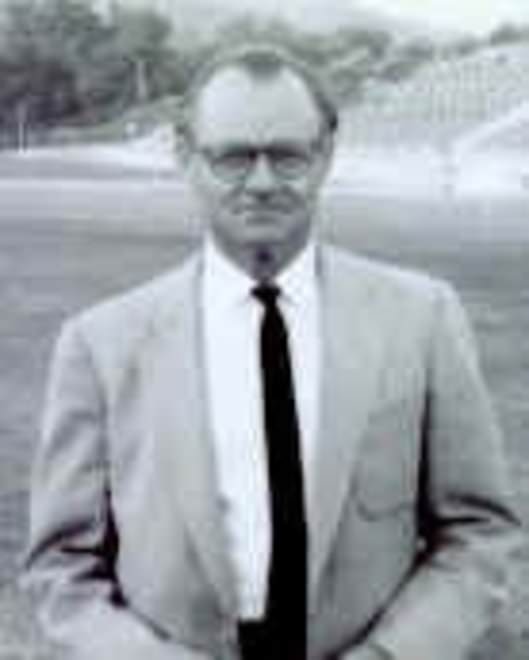 |
| Mihaly Igloi: the coachbehind the Hungariansuccesses in the 1950s. |
In 1955, the year before the Melbourne Olympics, Hungarian runners shocked the world with a slate of nine world records from 1,500 to 5,000. It was one of the greatest record explosions ever in track running. This breakthrough came from three runners: Sandor Iharos, Laszlo Tabori, and Istvan Rozsavolgyi. A crucial reason for this explosion was the coaching of Mihaly Igloi (see Profile). Igloi had become coach of the Army team Budapest Honved in 1951; he took over as Hungarian National Coach in 1953.
Before Igloi was appointed, Hungarian middle-distance running was already respectable. The following Hungarian runners, excepting the trio, appeared near the top of world rankings in the early fifties: 1951: Beres (5000); 1952: Beres, Garay (1500), Beres (5000); 1953: Kovacs, Penzes, Juhasz (10,000); 1954: Mikes (1500), Kovacs, Garay, Szabo, Beres (5,000). Kovacs, Juhasz (10,000). Particularly impressive was Joszef Kovacs, who ranked in the top three for 10,000 from 1953 to 1956, capping it all off with a second-place finish in the Melbourne Olympics.
Historical accounts tend to forget Kovacs because of the amazing 1955 performances of Iharos, Tabori and Rozsavolgyi. Iharos was the leader with five WRs. Tabori achieved two and also ran the third-ever sub-four Mile. Finally, Rozsavolgyi ran two WRs in the 1,000 and 2,000. In the 1955 world rankings, Hungary had 1,2,4 and 10 in the 1,500; 1,10,12 and 15 in the 3,000; 1,3,5,6,7 and 8 in the 5,000; and 2, 9 and 19 in the 10,000. This success was recognized in Sport Illustrated in an article headlined “Hungary Becomes a Great Power—in Track.” (SI, Nov. 21, 1955)
So Iharos, Tabori, and Rozsavolgyi were the tip of the iceberg, the best three of a remarkable blossoming of running talent to emerge from Hungary in the early 1950s.
The trio continued to perform well in 1956 during the build-up for the Olympics. Iharos added the Six Miles and 10,000 WRs to his list; Rozsavolgyi ran a 1,5000 WR. And Tabori ranked sixth in both the 1,500 and 3,000. Sadly, their Olympic hopes were decimated by the 1956 Soviet invasion of Hungary just before the Melbourne Olympics.
Only Tabori performed well in Melbourne; Iharos didn’t even make the trip to the Games. And in 1957, none of the trio appeared in the top rankings. Their coach, Igloi, didn’t return to Hungary after the Games, choosing California instead. Tabori went with him.
Laszlo Tabori
b. 1931
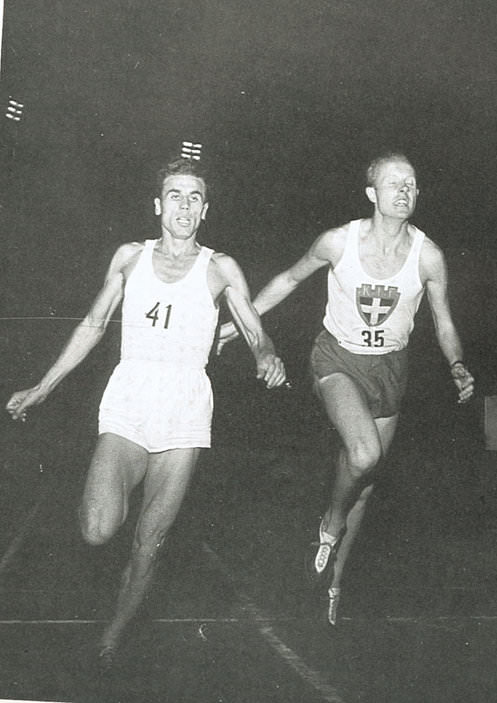 |
| Tabori beating Nielsen. |
Tabori claimed he learnt running in WW2, when he stole food and then ran away from German soldiers. He showed promise with a 4:11 1,500 when he was 19. Like all young Hungarians he had to do his military service; fortunately he was able to train with the excellent Honved Army club under Mihaly Igloi.
His first major success was as a member of 1953 and 1954 Hungarian world-record relay teams for 4x1,500. He first appeared near the top of world rankings in 1954, as Laszlo Tabori Talabircsuk, with 3:47.0 for 1,500 and 4:05.2 for the Mile.
After leaving the army in 1955, he found work in the leather factory he had worked in before his military service. This was the year when he emerged as a world leader. He burst onto the international scene by running the third-ever 4-minute Mile in 3:59.0, beating Chataway and Hewson, who finished second and third, both in 3:59.8. “I know only vaguely what the mile distance is,” he was quoted as saying at the time. (SI, Nov. 21, 1955) Sensibly, Tabori stayed back as the field went through in 59.9 and 2:00.8 for the first half of the race, perfect pace-setting for a sub-4. Hewson took lead in the back straight of third lap and led at bell in 3:02 with Chataway and Tabori trailing by 3-4 yards. By the back straight Tabori had closed the gap. He was third coming into the straight, but in the last 50 yards he passed both Brits to win.
In 1955, Tabori also ran 3:41.2 and 3:41.6 for 1,500 and 5:03 for 2,000, which was under the WR of 5:07, but he lost to Rozsavolgyi (5:02.2) in this race. Then he equaled Iharos’s WR for 1,500 in 3:40.8. This was done in Oslo, where he beat Nielsen by inches. Further, he ranked 10th in 3,000 8:11.6.
His 1956 track season was successful, though there was no improvement over 1,500. He ran 3:42 for that distance, while improving to 8:00.8 for the 3,000. Tabori performed well at Melbourne following the Soviet invasion of his country. Although he lost three weeks’ training, he ran a fine 1,500 in a tight race, placing fourth in 3:42.04. His sixth-place 5,000 run was also impressive. After the Games he went straight to the USA with his coach.
In California Tabori continued competing until 1962, running a 4:00.5 mile in 1958 and 13:52.6 for 5,000 in 1960. But since he had defected, he was not qualified to run for Hungary in the Rome Olympics. After retiring, Tabori worked for a few years on wheelchair design and then formed the successful San Fernando Valley Track Club. He busied himself with coaching and running a shoe store. Using the Igloi method, he had some success as a coach.
Tabori was one of the great runners of the fifties, but the disruption of his life in 1956 meant that he never reached his full potential. He later said he had no regrets but wished he had won a medal in Melbourne. His pre-Invasion form suggests he could well have medaled.
Sandor Iharos
1930-1996
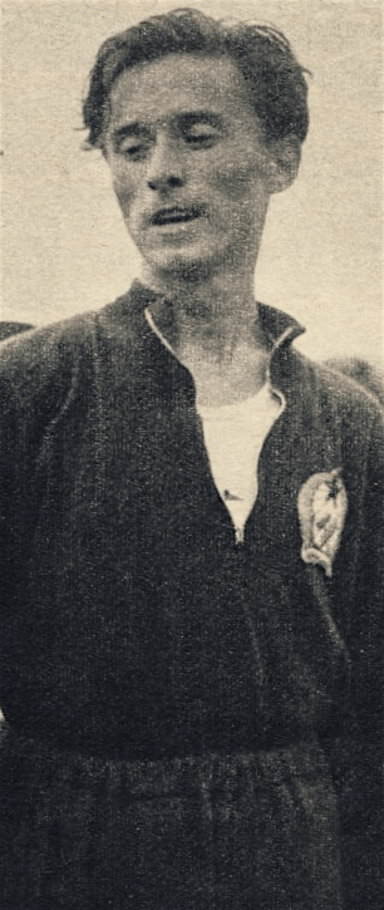 |
Sandor Iharos, originally Sandor Israel, achieved his greatest successes in the 1955 banner year, and of the three was most affected by the Russian invasion. The fact that he never joined the Communist Party—unusual at that time—suggests he was not at all sympathetic to the government. And as he had a family in Hungary, defection was hardly an option.
His first love was football, but he started running in 1948 with a 4:36 1,500. In 1950 he joined the army, having been a toolmaker. He joined the Honved Club to train under Igloi. His twice-a-day training produced a 3:49.3 1,500 in 1952 and a 3:42.4 and a 14:12.2 5,000 in 1954. But these respectable times gave no real indication that he would run five world records the next year. At age 25, he broke all world records from 1,500 to 5,000 (2 miles, 3,000 and 3 Miles in between). Indeed, he broke the 5,000 world record twice in a month.
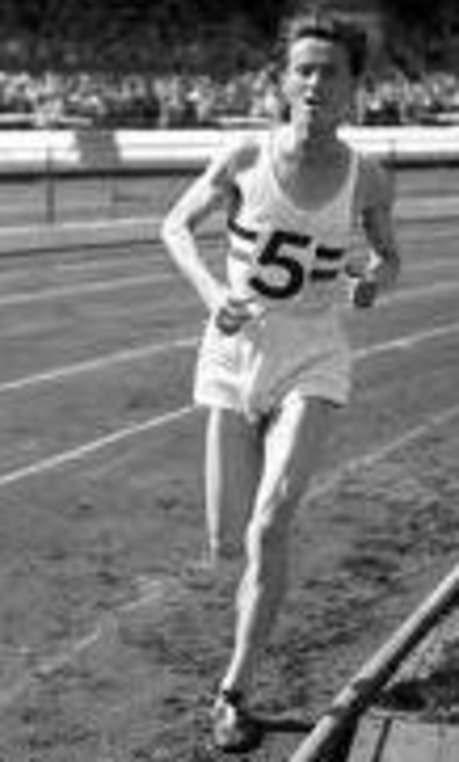 |
| Sandor Iharos. |
First he knocked more than three seconds off the 3,000 world record with 7:55.6. Then he showed amazing speed when breaking the 2 Miles world record by seven seconds. After hanging on to Ken Wood for six laps, he reeled off laps of 61.1 and 61.2 to finish in 8:33.4. The 5,000 was next. After a defeat over this distance by Poland’s Jerzy Chromik, Iharos had a better feel for this longer distance. In only his third 5,000 race he ran a 13:50.8 world record. Eight days later Kuts reclaimed his WR with 13:46.8, but late in October in Budapest Iharos responded with an astonishing 13:40.6.
His brilliant form continued into 1956 when he broke the 10,000 WR (28:42.8), as well as the 6 Miles WR on the way . Then his country was invaded, and he never made it to Melbourne, citing the unlikely reason that he had a dislocated ankle. In view of his early 1956 form, he would undoubtedly been a factor in the two distance races won by Kuts.
Iharos continued to compete for Hungary after 1956, but he never matched his 1955-56 form. His best 5,000 times were 13:57.2 (1958) and 13:50.8 (1959). No doubt the political situation in Hungary and the absence of his coach were the main reasons for his decline. An elegant runner who seemed to flow effortlessly round the track, Iharos was more a record breaker than a competitor; he never won an Olympic or European medal. But this tall, slight runner—almost 6 ft tall and only 132 lbs—will always be remembered for his great running in 1955 and early 1956.
Istvan Rozsavolgyi
b. 1929
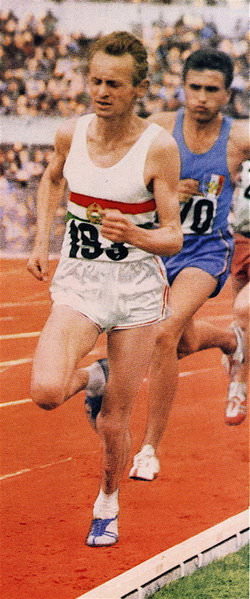 |
| Rozsavolgyi chasing Elliottin the 1960 Olympic 1,500.Jazy follows him. |
Originally a soccer player like Iharos, Rozsavolgyi’s running talent was discovered by Mihaly Igloi. It took Igloi six months to convert him to running. Rozsavolgyi was said to have the most natural talent of the three. He was definitely the fastest. He raced mainly at 1,500 and ran a fast 1:48.8 800.
Rozsavolgyi’s progress was steady. From 1953 to 1956 he improved each year over 1,500: 3:47.4, 3:46.6, 3:41.2, 3:40.5. After an off-year in 1957 following the Soviet invasion, he improved in each of the next three years: 3:40.0, 3:38.9, 3:38.8.
Like Iharos and Tabori, he had a great year in 1955. After running the fourth best 1,500 of the year (3:41.2), he broke two world records in September and October: 1,000 in 2:19 and 2,000 in 5:02.2 (just ahead of Tabori, who ran 5:03). His 2,000 world record lasted seven years.
Then in 1956, before the Soviet invasion, he beat the 1,500 world record with 3:40.5, just 3/10ths better than Iharos, Tabori and Nielsen, who all had a share the world record. (Clearly 3:40 was a psychological barrier for the 1,500 just like the 4-minute mile.) As well, Rozsavolgyi had three of the six best 1,500 times for 1956. He looked likely to medal in Melbourne, but clearly affected by political events, he failed to get through the heats.
In 1958 he was back near top form. He ran 3:42.7 for fourth in the European 1,500 and later ran a PB of 3:40.0. But the WR was now 3:38.1. In 1959 at 30 years of age, he was ranked first in the world with 3:38.9 and looked an excellent prospect for the Rome Olympics.
He did perform brilliantly in the Rome 1,500, but two younger runners were too fast for him, and the 31-year-old could only manage third, albeit in the excellent time of 3:39.2. He was almost four seconds behind winner Herb Elliott (22) and almost a second behind second-place Michel Jazy (24). A new generation of runners was now firmly established. Rozsavolgyi continued to compete and managed a 13:59 5,000 in 1961; however, his glory days were over. 
8 Comments